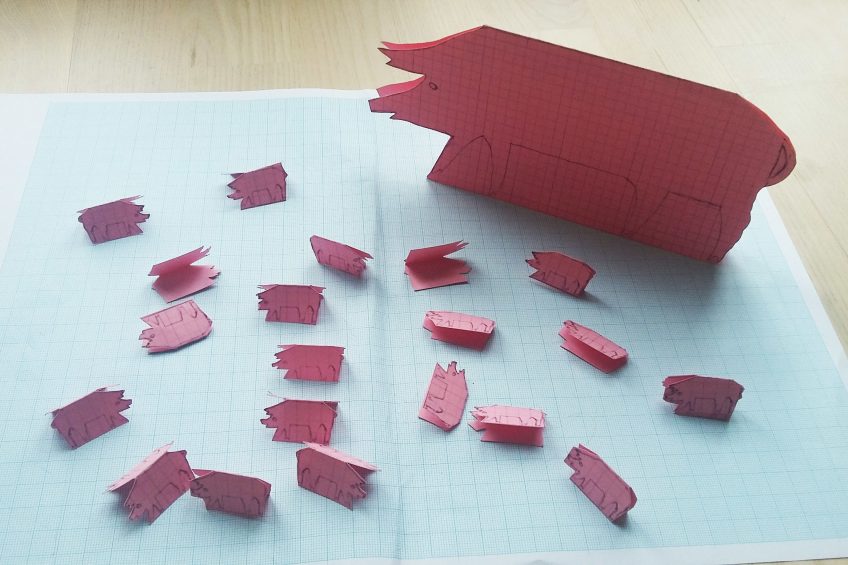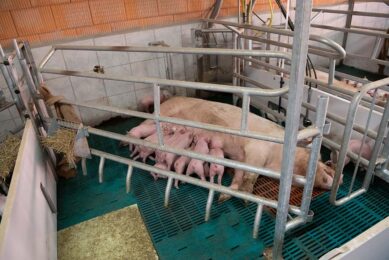Small details make a difference in pig pens

How difficult can it be to design a good pig pen? It pays off to understand and incorporate normal pig behaviour when designing them, writes housing and welfare expert Vivi Aarestup Moustsen.
All pigs need a place to eat and drink, to rest and sleep and to dung and urinate. So it ought to be easy to design pens. And yet, the function of pens varies so much between herds. Often small changes or details make a difference.
A common characteristic for the features below, were, that they were designed based on sow behaviour and motivation and sow and piglet dimensions. This is a prerequisite for pen designs – also for sows and piglets in the farrowing unit.
Example 1 – Improving quality of lying area in pens with ESF
A herd build for loose gestating sows prior to January 2013 and decided for Electronic Sow Feeders (ESF) and stable groups, so 1 week of sows (about 60 gilts and sows) in each pen. Within each pen the lying area was divided by walls to make it more attractive for the sows, see below.
However, the sows very often defecated and urinated in the transition area between the lying area and the activity/ dunging area, which cause extra work, higher ammonia emissions and risk of the floor being slippery. Then, different positions and height of walls were tested. One treatment had low walls (40 cm high and 200 cm long, which is a sow’s length), see image below.

This gave the sows walls to lie by, it gave the caretakers a much better view of the pens, and lying areas were cleaner and drier, which will benefit sow conditions too. An extra benefit with as opposed to higher walls, is improved air quality because of the air being shifted.
Sows are less than a meter tall, and when lying down 45-55 cm ‘tall’, so a wall of 40-60 cm is sufficient to make it attractive to lie next to it.
Example 2 – Motivate loose sows to dung in specific part of the pen
With inspiration from the Netherlands, a ‘dunging wall’ was introduced last year in the activity area, where caretakers in the Danish herd experienced that sows like to stand by when dunging.

Example 3 – Farrowing pens for loose sows
A few months ago, the Loose Lactating Sow workshop was held in Copenhagen, Denmark (for more information – read the weblogs ’Loose lactation for sows – fantastic and frustrating’ and ’Improvement in pig welfare through collaboration’). There, sow and piglet models scaled 1:10 were used when discussing potential pens for loose lactating sows, see below.

In farrowing pens for loose sows, it is also very important to take in to account the behaviour and motivations of sows and piglets; dimensions of sows and piglets and motivation of caretakers to make the best designs for both the sows and the piglets and their caretakers.
Piglet mortality is an issue – not the least if the sows are loose, and the main cause of death is crushing. However, for a piglet to be crushed it must be near the sow and sow must move. So as one initiative to reduce crushing, work is ongoing to design areas – safe zones – for the piglets that are attractive to them and then reduce the risk both along pen sides and in the creep, see the picture below.

Taking into account dimensions of piglets
For the creep this includes both taking into account dimensions of piglets – and sows, so they don’t enter the areas too – and motivation for piglets such as temperature, structure, surfaces, odours and maybe sounds too.
Another example is if piglets are given supplementary milk in the farrowing pen, it’s important that they have good access to the milk – so take into account shoulder width and length of piglets when placing the milk cup.
Read more on pig pen designs (in Danish and English):
- Dunging wall
- Lying wall
- Piglet dimensions
- Sow dimensions
- More on behaviour and motivation of farrowing and lactating sows











